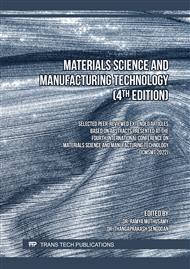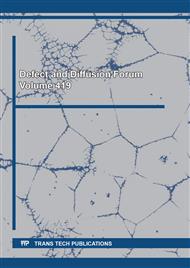[1]
B. Predel, Thermodynamic properties and structure of liquid alloys, Berichte der Bunsengesellschaft für physikalische Chemie.80 (8) (1976) 695-704.
DOI: 10.1002/bbpc.19760800805
Google Scholar
[2]
I.B. Bhandari, N. Panthi, I. Koirala and D. Adhikari, Phase segregating and complex forming Pb-based (= X-Pb) liquid alloys, Phase Transit. 1 (2021) 338-352.
DOI: 10.1080/01411594.2021.1933485
Google Scholar
[3]
D. Adhikari, B.P. Singh and I.S. Jha, Phase separation in Na–K liquid alloy, Phase Transit.. 85(8), (2012) 675-680.
DOI: 10.1080/01411594.2011.635903
Google Scholar
[4]
N. Panthi, I.B. Bhandari and I. Koirala, Theoretical assessment on hetero-coordination of Alloys Silver-Antimony at Molten State, Himalayan Journal of Science and Technology, 3-4 (2020) 68-73.
DOI: 10.3126/hijost.v4i0.33871
Google Scholar
[5]
P.J. Flory, Thermodynamics of high polymer solutions, J. Chem. Phys. 10(1) (1942) 51-61.
Google Scholar
[6]
O. Redlich and A.T. Kister. Algebraic representation of thermodynamic properties and the classification of solutions, Ind Eng Chem .40(2) (1948) 345-348.
DOI: 10.1021/ie50458a036
Google Scholar
[7]
A.B. Bhatia and N.H. March. Size effects, peaks in concentration fluctuations and liquidus curves of Na-Cs, J. Phys. F: Met. Phys. 5(6) (1975) 1100-1106.
DOI: 10.1088/0305-4608/5/6/011
Google Scholar
[8]
A.B. Bhatia and R.N. Singh. Thermodynamic properties of compound forming molten alloys in a weak interaction approximation, Phys Chem Liquids.11 (1982) 343-353.
DOI: 10.1080/00319108208080755
Google Scholar
[9]
A.B. Bhatia and R.N. Singh. A quasi-lattice theory for compound forming molten alloys. Phys Chem Liquids, 13 (3) (1984) 177-190.
DOI: 10.1080/00319108408080778
Google Scholar
[10]
R.N. Singh and I.K. Mishra. Conditional probabilities and thermodynamics of binary molten alloys, Phys Chem Liquids.18 (4) (1988)303-319.
DOI: 10.1080/00319108808078606
Google Scholar
[11]
R. Novakovic. Thermodynamics, surface properties and microscopic functions of liquid Al–Nb and Nb–Ti alloys. Journal of Non-Crystalline Solids. 31-32 (2010) 1593-1598.
DOI: 10.1016/j.jnoncrysol.2010.05.055
Google Scholar
[12]
R. Novakovic, T. Tanaka, M.L. Muolo, J. Lee and A. Passerone. Bulk and surface properties of liquid Ag–X (X= Ti, Hf) compound forming alloys, Surf. Sci.1-3 (2005)56-59.
DOI: 10.1016/j.susc.2005.06.022
Google Scholar
[13]
Panthi, N., Bhandari, I. B. & Koirala, I.Thermophysical behavior of mercury-lead liquid alloy, Papers in Physics.14(2022)14005.
DOI: 10.4279/pip.140005
Google Scholar
[14]
I. Budai, M.Z. Benkő and G. Kaptay. Comparison of different theoretical models to experimental data on viscosity of binary liquid alloys, In Materials science forum. 537 (2007) 489-496.
DOI: 10.4028/www.scientific.net/msf.537-538.489
Google Scholar
[15]
G.Kaptay.Improved derivation of the Butler equations for surface tension of solutions, Langmuir. 35(33) (2019)10987-10992.
DOI: 10.1021/acs.langmuir.9b01892
Google Scholar
[16]
S.L. Chen, S.S. Daniel, F. Zhang, Y.A. Chang, W.A. Oates and R. Schmid-Fetzer. On the calculation of multicomponent stable phase diagrams, J. Ph. Equilibria Diffus. 22 (4) (2001) 373-378.
DOI: 10.1361/105497101770332910
Google Scholar
[17]
R.K. Gohivar, S. K., Yadav, R.P. Koirala and D. Adhikari. Assessment of thermo-structural properties of Al-Fe and Fe-Si alloys at high temperatures, Phys Chem Liquids. 1 (2020) 679-689.
DOI: 10.1080/00319104.2020.1793985
Google Scholar
[18]
N. Panthi, I.B. Bhandari, R.K. Rai, and I. Koirala. Thermophysical Behavior of Sodium Lead Alloy at Different Temperature, Adv. Stud. Theor. Phys. 15 (4) (2021) 153-165.
DOI: 10.12988/astp.2021.91548
Google Scholar
[19]
G. Kaptay. A new equation for the temperature dependence of the excess Gibbs energy of solution phases, Calphad. 28(2) (2004) 115-124.
DOI: 10.1016/j.calphad.2004.08.005
Google Scholar
[20]
G.Kaptay. The exponential excess Gibbs energy model revisited. Calphad.56 (2017)169-184.
DOI: 10.1016/j.calphad.2017.01.002
Google Scholar
[21]
Q. Zhang, J. Mao, W.K. Pang, T. Zheng, V. Sencadas, Y. Chen and Z. Guo. Boosting the potassium storage performance of alloy‐based anode materials via electrolyte salt chemistry, Adv. Energy Mater. 8(15) (2018) 1703288.
DOI: 10.1002/aenm.201703288
Google Scholar
[22]
A.B. Bhatia and D.E. Thornton. Structural aspects of the electrical resistivity of binary alloys, Phys. Rev. B. 2(8) (1970) 3004-3012.
DOI: 10.1103/physrevb.2.3004
Google Scholar
[23]
G. Kaptay. A unified model for the cohesive enthalpy, critical temperature, surface tension and volume thermal expansion coefficient of liquid metals of bcc, fcc and hcp crystals, Mater. Sci. Eng. A. 495(1-2) (2008) 19-26.
DOI: 10.1016/j.msea.2007.10.112
Google Scholar
[24]
E.A. Brandes and G.B. Brook (Eds.). Smithells metals reference book, Elsevier, (2013).
Google Scholar
[25]
R.Hultgren, P.D. Desai, D.T. Hawkins, M. Gleiser and K.K. Kelley. Selected values of the thermodynamic properties of binary alloys, National Standard Reference Data System, Ohio, (1973).
Google Scholar
[26]
I.S. Jha, R. Khadka, R.P. Koirala, B. P.Singh, and D. Adhikari. Theoretical assessment on mixing properties of liquid Tl–Na alloys, Philos. Mag. 96(16) (2016) 1664-1683.
DOI: 10.1080/14786435.2016.1177668
Google Scholar
[27]
G. Kaptay. A coherent set of model equations for various surface and interface energies in systems with liquid and solid metals and alloys, Adv. Colloid Interface Sci.283 (2020) 102212.
DOI: 10.1016/j.cis.2020.102212
Google Scholar



